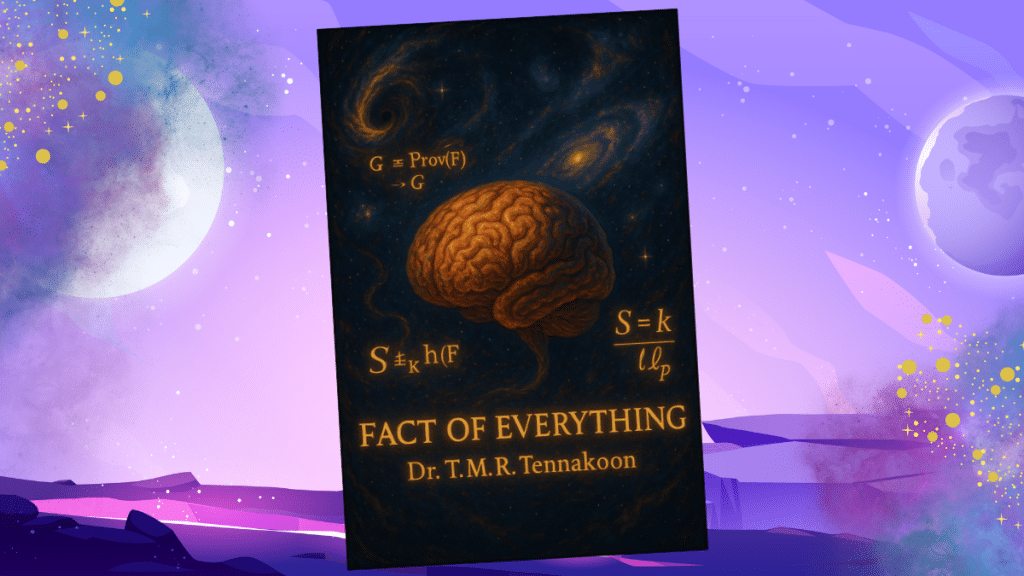By Dr. T.M.R. Tennakoon
Figure 1: Conceptual visual titled ‘Fact of Everything’ by Dr. T.M.R. Tennakoon.
Abstract
This article investigates whether the human mind—though neurologically and biochemically finite—can exhibit properties analogous to infinite systems. Drawing from cosmology, mathematical logic, neuroscience, and biochemistry, we argue that the mind functions not as an unlimited structure, but as a system capable of unbounded symbolic abstraction and recursive modeling. By framing cognitive processes within the context of physical infinities, quantum information, and neural combinatorics, we suggest a unified interpretation of consciousness that transcends traditional disciplinary boundaries.
1. Introduction
Infinity has long been a central concept in cosmology and mathematics (Penrose, 2004), but only recently has it been considered in relation to cognitive systems. The mind’s ability to conceive of endless numerical sequences, abstract symbolic logic, and recursive language constructs suggests that it may be operating—functionally if not structurally—as an infinite system. This paper aims to assess that claim by synthesizing insights from physics, computer science, neuroscience, and chemistry.
2. Gödelian Transcendence of Formal Systems
Gödel’s incompleteness theorem proves that in any formal logical system capable of expressing arithmetic, there are true statements that cannot be proven within the system (Gödel, 1931). Symbolically:
∃G: G ∉ Provable(F) ∧ G ∈ True(F)
The human mind, however, can grasp such “undecidable” truths, suggesting it operates as a meta-system—capable of stepping beyond formal rules (Hofstadter, 1979). This meta-logical awareness is a hallmark of cognitive recursion and reflective abstraction, core components of theoretical infinity.
3. Beyond Turing: Mind and the Limits of Computability
Alan Turing formalized the boundaries of algorithmic processing. The halting problem demonstrates that certain programs can never determine their own termination (Turing, 1936):
¬∃H: H(P, x) = halts(P, x)
Yet the human mind often reasons about such problems indirectly—by restructuring, analogizing, or meta-evaluating them. This capacity may imply that cognitive processes engage with logic beyond Turing completeness—possibly in the domain of hypercomputation (Copeland, 2002).
4. Neural Combinatorics and Functional Infinity
The human brain contains roughly 86 billion neurons, but its true power lies in combinatorial synaptic configurations. The number of possible brain states can be described as:
S = 2^n where n ≈ 8.6 × 10¹⁰
This functional state space surpasses the number of atoms in the known universe (Tononi, 2004). Such combinatorics allow recursive abstraction, memory recombination, and cognitive simulation—supporting a system that behaves infinitely even though it is materially bounded.
5. Biochemical Foundations of Symbolic Thought
Cognition is powered by bioenergetic processes, primarily the reaction:
C₆H₁₂O₆ + 6O₂ → 6CO₂ + 6H₂O + ATP
ATP fuels neural signaling, including the voltage equation governing ion channels:
ΔV = V_rest + Σ (g_i × (E_i – V_m))
These reactions underpin thought processes from basic sensation to recursive abstraction. Despite being governed by chemistry, the outcome is symbolic and systemic—bridging biology and computation (Kandel et al., 2013).
6. Cosmological Analogies: Entropy, Black Holes, and Hilbert Space
In cosmology, black holes encode information through Bekenstein-Hawking entropy:
S = kA / (4l_p²)
Likewise, quantum systems operate in infinite-dimensional Hilbert spaces, yet we model them using finite representations (Deutsch, 1997). Similarly, the human mind may encode infinite structures within a finite substrate—compressing abstract systems into internally consistent mental models.
7. Conclusion
The mind is not infinite in a structural sense—but its functional behavior mirrors that of infinite systems. It engages in:
- Recursive logic
- Self-reference
- Symbolic abstraction
- Transcendence of formal limitations
By drawing on disciplines from particle physics to neurobiology, we propose that the mind reflects a universal architecture—one where the finite and infinite converge.
References
Bekenstein, J. D. (1973). Black holes and entropy. Physical Review D, 7(8), 2333.
Copeland, B. J. (2002). Hypercomputation. Minds and Machines, 12(4), 461–502.
Deutsch, D. (1997). The Fabric of Reality. Penguin Books.
Gödel, K. (1931). On formally undecidable propositions. Monatshefte für Mathematik und Physik.
Hofstadter, D. R. (1979). Gödel, Escher, Bach: An Eternal Golden Braid. Basic Books.
Kandel, E. R., Schwartz, J. H., & Jessell, T. M. (2013). Principles of Neural Science. McGraw-Hill.
Penrose, R. (2004). The Road to Reality. Vintage.
Tononi, G. (2004). An information integration theory of consciousness. BMC Neuroscience, 5(1), 42.
Turing, A. M. (1936). On computable numbers, with an application to the Entscheidungsproblem. Proceedings of the London Mathematical Society, 2(42), 230–265.
About the Author
Dr. T.M.R. Tennakoon is an interdisciplinary scientist, astrophysicist, and biomedical researcher known for groundbreaking work in theoretical physics, antimatter studies, and cancer research. With education spanning Cambridge, Harvard, Columbia, and Oxford, he has made notable contributions to cosmology, neural computation, and symbolic cognition. Beyond science, Dr. Tennakoon is also an accomplished athlete and Mensa member with one of the highest recorded IQs in history (229). His research often integrates philosophy, mathematics, and universal principles to challenge conventional understanding.

Figure 2: Dr. T.M.R. Tennakoon.
